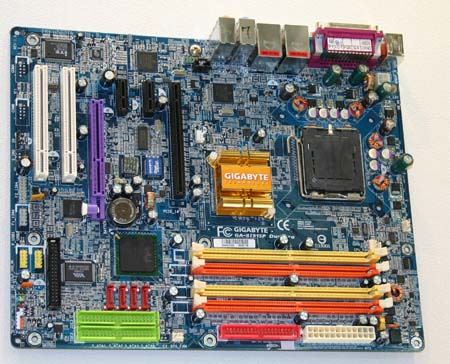AGP on Intel 9xx chipsets? We explain how.
by Anand Lal Shimpi on June 4, 2004 2:05 AM EST- Posted in
- Motherboards
At Computex we saw something very interesting - both Intel and SiS based motherboards featuring dual graphics slots, AGP and PCI Express x16 to be specific. What makes these dual slot motherboards so interesting is that supposedly on VIA's chipsets actually featured both AGP and PCI Express x16 interfaces. So were Intel and SiS pressured into following in VIA's footsteps? We hit the show floor at Computex to try and find out.
Gigabyte had a board on display when we did our Early Bird Computex coverage that used Intel's 915 chipset and featured both slots, but when we went back to visit their booth the motherboard had mysteriously disappeared. In fact, when we asked Gigabyte about it they denied all knowledge of the board. Curious.

Click to Enlarge Gigabyte's disappearing 915 board
ECS also had a board on display with similar properties, but unlike Gigabyte they were not afraid to show it. They informed all who asked that there was a performance hit when using the AGP slot on their motherboard (between 5 - 20%), but they didn't really explain how it was done. ECS also mentioned that you could populate both AGP and PCI Express x16 slots at the same time, but also, they didn't really explain how it worked.
Further inspection revealed that on both the Gigabyte and ECS boards there were no bridge chips or ASICs that would explain how they acheived adding AGP support to chipsets that supposedly don't support it. So were we just lied to? Does Intel actually support AGP and are they not telling anyone about it? As nice as that would be to believe, it's wrong.
Instead, what the manufacturers have done is gotten a little creative with their AGP interfaces and are actually running the slot off of the PCI bus, stemming from the South Bridge. Remember that the AGP interface is only 32-bits wide, the same width as the PCI bus and you can actually run an AGP card in PCI mode, giving up all of the benefits of AGP obviously. Remember that the PCI bus runs at 33MHz, offering only 133MB/s of bandwidth vs. AGP 8X's 2.1GB/s of bandwidth to the card. The incredible drop in bandwidth explains the performance hit, and although we haven't tested any of these solutions we'd say that running a fast AGP card on the PCI bus is probably not the best idea for performance. It was a valiant effort by these motherboard companies, but if you're interested in a high performance system then this isn't a solution. You'll either have to turn to VIA or bite the bullet and buy a PCI Express x16 card when they're available.
We believe that the SiS board we saw was most likely using a similar technique to achieve both AGP and PCI Express x16 support. This would also explain why the AGP slot on these boards was located far away from the North Bridge, which would normally be a routing/trace length nightmare.










15 Comments
View All Comments
DerekWilson - Friday, June 4, 2004 - link
so 32bit 33MHz has a max bandwidth of 133MB/s obviously (4 bytes * 33.3 MHz) ...maybe if we could ever get a copy of the actual PCI Express specifications we could tell you just how much data you could transfere (its not as easy as width times speed since bus utilization is much lower due to the fact that control signals must also be sent serially).
If we are to believe what we've been hearing about x16 PCI Express with graphics cards, then we would talking about a maximum of 500MB/s (8GB/s / 16) ... Though the effective bandwidth could be much lower than that (though probably not lower than 256MB/s) depending on what kind of control and signallling goes on. So x1 PCIe is, at maximum, less than a quarter of the speed of AGP 8x. Which means it will also be much less (utilization issues) than the speed of a 64bit 66MHz PCI slot (533MB/s).
the nice little x4 PCIe slots will do well for high bandwidth devices that need something like a 64bit 66MHz PCI or a PCI-X slot right now (I'd like four gigabit ethernet ports in one slot please).
Filibuster - Friday, June 4, 2004 - link
>Why don't they put the AGP on a PCI-Express 1x instead of the old 32-bit 33 MHz PCI?Because PCIexpress is serial and PCI/AGP are parallel, so it would be much more difficult to adapt. Basically the HSI chip Nvidia is using would have to be on the motherboard, along with any trace design that it requires.
1X PCIExpress isn't much faster than standard PCI either, at least when you compare it to 2G/s AGP.
kherman - Friday, June 4, 2004 - link
I'll laugh if Intel AGP cards don't work because they didn't follow the AGP standard. Didn't they drop the ball on that once before with AGP slots. Something about supporting both 3.3V and 5V interfaces to AGP slots?AtaStrumf - Friday, June 4, 2004 - link
Why don't they put the AGP on a PCI-Express 1x instead of the old 32-bit 33 MHz PCI?skiboysteve - Friday, June 4, 2004 - link
crazy bastards